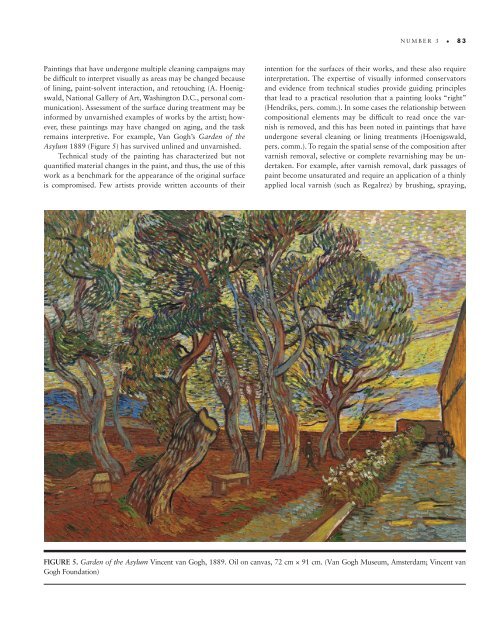Create successful ePaper yourself
Turn your PDF publications into a flip-book with our unique Google optimized e-Paper software.
number 3 • 83<br />
<strong>Paintings</strong> that have undergone multiple cleaning campaigns may<br />
be difficult to interpret visually as areas may be changed because<br />
<strong>of</strong> lining, paint- solvent interaction, and retouching (A. Hoenigswald,<br />
National Gallery <strong>of</strong> Art, Washington D.C., personal communication).<br />
Assessment <strong>of</strong> <strong>the</strong> surface during treatment may be<br />
informed by unvarnished examples <strong>of</strong> works by <strong>the</strong> artist; however,<br />
<strong>the</strong>se paintings may have changed on aging, and <strong>the</strong> task<br />
remains interpretive. For example, Van Gogh’s Garden <strong>of</strong> <strong>the</strong><br />
Asylum 1889 (Figure 5) has survived unlined and unvarnished.<br />
Technical study <strong>of</strong> <strong>the</strong> painting has characterized but not<br />
quantified material changes in <strong>the</strong> paint, and thus, <strong>the</strong> use <strong>of</strong> this<br />
work as a benchmark for <strong>the</strong> appearance <strong>of</strong> <strong>the</strong> original surface<br />
is compromised. Few artists provide written accounts <strong>of</strong> <strong>the</strong>ir<br />
intention for <strong>the</strong> surfaces <strong>of</strong> <strong>the</strong>ir works, and <strong>the</strong>se also require<br />
interpretation. The expertise <strong>of</strong> visually informed conservators<br />
and evidence from technical studies provide guiding principles<br />
that lead to a practical resolution that a painting looks “right”<br />
(Hendriks, pers. comm.). In some cases <strong>the</strong> relationship between<br />
compositional elements may be difficult to read once <strong>the</strong> varnish<br />
is removed, and this has been noted in paintings that have<br />
undergone several cleaning or lining treatments (Hoenigswald,<br />
pers. comm.). To regain <strong>the</strong> spatial sense <strong>of</strong> <strong>the</strong> composition after<br />
varnish removal, selective or complete revarnishing may be undertaken.<br />
For example, after varnish removal, dark passages <strong>of</strong><br />
paint become unsaturated and require an application <strong>of</strong> a thinly<br />
applied local varnish (such as Regalrez) by brushing, spraying,<br />
FIGURE 5. Garden <strong>of</strong> <strong>the</strong> Asylum Vincent van Gogh, 1889. Oil on canvas, 72 cm × 91 cm. (Van Gogh Museum, Amsterdam; Vincent van<br />
Gogh Foundation)
















